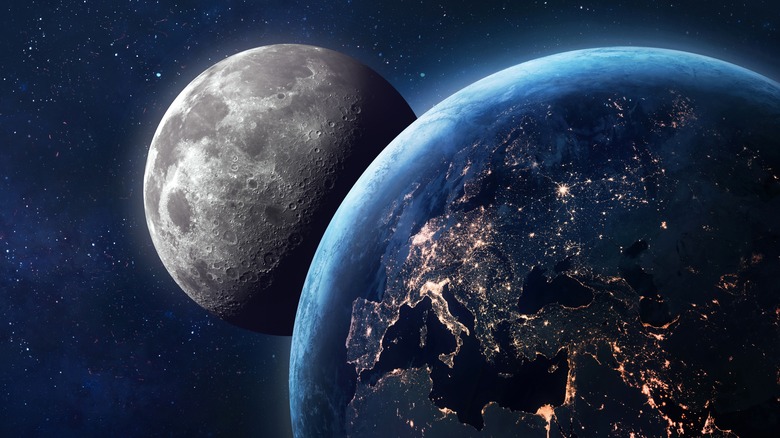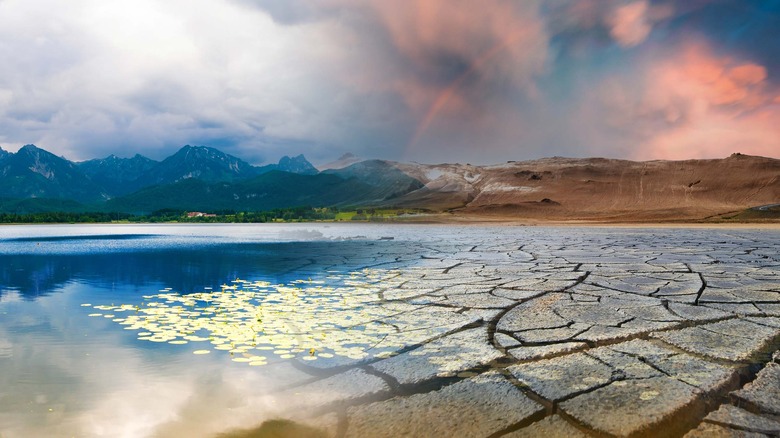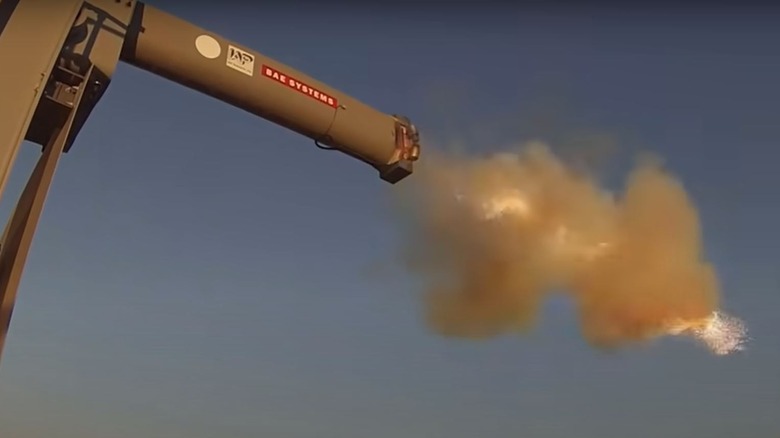The Risky And Bizarre Way That The Moon Could Reduce Global Warming
So you know that whole global warming thing? Boiling oceans, dusty and dead soil, thundering floods consuming coastal cities, a ravaged and endless hellscape blighted by pockets of damned humanity? Fun times. Well how about we bypass all the hard work of figuring out a sensible, rational, cooperative way of dealing with our fossil fuel-guzzling greed? No G7 summit for global leaders to have polite chats, no Greta Thunberg riding boats and waving hand-painted signs, no solar panels on rooftops, and no reduced energy consumption at all. Here's the plan: We take a big ole' gun — folks love those — and point it at the moon, right? Pew, pew! Take that, moon! Shield us in a cloak of your space dust!
Well believe it or not (facepalms incoming), that's an actual proposal set forth by Professor of Physics and Astronomy at the University of Utah Benjamin Bromley, as New Scientist describes. What could go wrong? We'll have to ask Earth's survivors when they satirize our present in their shadows-on-the-wall cave performance of "Deserving Death: A Tale of Guns, Moons, and Morons." But wait, maybe it's not all that ridiculous. After all, New Scientist says that this basic idea has been on the table for quite awhile. The plan boils down to releasing a whole bunch of moon dust — more than 100 million tons — into a gravitationally locked pocket orbiting Earth. The dust would hover in that pocket, Lagrange point 1, right between us and the sun.
A short-term band-aid solution
If you're thinking at this point, "Hang on, that moon dust thing just masks the problem of global warming and doesn't solve its causes," then ding, ding — you're right. It's definitely the climatological version of a Band-Aid meant to cloak a wound from dirt and bacteria, and just that. The dirt and bacteria, in this analogy, is additional solar heat added to the heat generated by the carbon dioxide that's accumulated in the atmosphere since the birth of the Industrial Revolution. The idea, as New Scientist outlines, is to buy us some time and give us leeway to concoct a more permanent, long-term solution. But let's be honest: Would you expect folks to jump on a long-term solution if we implemented such a short-term solution? Or would they just procrastinate and gaze up at the hazy blob of space dust obscuring the sun while mumbling, "Eh, it can wait"?
That being said, there might be enough environmental pressures at work during this temporary solution period to push us toward developing a more permanent way to curb our carbon dioxide appetite. Cloaking Earth in a shield of moon dust wouldn't be without its effects below. As the dust scatters light away from patches of Earth's surface, our planet's entire ecology would undergo a radical change, as New Scientist says. Aside from the obvious temperature differences, we'd get resultant changes to weather, wind, and precipitation patterns, which itself would affect all agricultural ventures and animal and plant life worldwide.
Railguns pointed at the sky
In case this whole moon dust solution isn't settling well with you, we've got one more component to add to the mix: a humongous railgun. A railgun uses electromagnetism to shoot a projectile rather than a chemical explosion like that of gunpowder. Railgun projectiles don't explode like bombs, however — they just puncture things at really high velocities and with extremely potent force, like gigantic bullets. You know how NASA recently shot its DART spacecraft at the asteroid Dimorphos as a test of Earth's first "planetary defense technology"? Yes, this happened. This moon dust shield plan rehashes the same principle, the one that's guided firearms for hundreds of years: point, aim, shoot, win.
Plan-hatcher Benjamin Bromley says that we'd need "a few square kilometers of solar panels" near the gun's site to power it, per New Scientist. The railgun's projectile needs to strike the moon's north pole and release "a stream of lunar dust" spewing forth at 2.8 kilometers per second, the outlet says. Each particle of dust would deflect sunlight for about five days. The good news? The dust will naturally dissipate after that, so we don't have to worry about cleaning up this particular celestial mess of ours (which might not be good for teaching us lasting lessons). Until then, the dust would hang in place 1.5 million kilometers from Earth at Lagrange point 1, suspended at a spot caught between Earth's and the sun's gravity.


